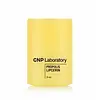What's inside
What's inside
 Key Ingredients
Key Ingredients

 Benefits
Benefits

 Concerns
Concerns

 Ingredients Side-by-side
Ingredients Side-by-side

Triethylhexanoin
MaskingPhytosteryl/Isostearyl/Cetyl/Stearyl/Behenyl Dimer Dilinoleate
Skin ConditioningDiisostearyl Malate
EmollientBis-Diglyceryl Polyacyladipate-2
EmollientDextrin Palmitate
EmulsifyingDipentaerythrityl Hexahydroxystearate/Hexastearate/Hexarosinate
Skin ConditioningGlyceryl Behenate/Eicosadioate
EmollientGlycerin
HumectantWater
Skin ConditioningSilica Dimethyl Silylate
Emollient1,2-Hexanediol
Skin ConditioningSorbitan Stearate
EmulsifyingCedrol
EmollientDimethicone
EmollientParfum
MaskingGluconolactone
Skin ConditioningHelianthus Annuus Seed Oil
EmollientSucralose
Skin ConditioningProtease
ExfoliatingButylene Glycol
HumectantMadecassoside
AntioxidantSerine
MaskingCholesterol
EmollientHydrogenated Lecithin
EmulsifyingBeta-Carotene
Skin ConditioningDaucus Carota Sativa Root Extract
Skin ConditioningDaucus Carota Sativa Seed Oil
EmollientSqualane
EmollientButyrospermum Parkii Butter
Skin ConditioningGlyceryl Glucoside
HumectantAlcohol Denat.
AntimicrobialPropolis Extract
Skin ConditioningCetearyl Alcohol
EmollientTocopherol
AntioxidantStearic Acid
CleansingHoney Extract
HumectantCodonopsis Lanceolata Root Extract
Skin ConditioningFicus Carica Fruit Extract
HumectantMelissa Officinalis Leaf Extract
Skin ConditioningPunica Granatum Fruit Extract
AntioxidantAcetyl Tetrapeptide-9
Skin ConditioningBeta-Glucan
Skin ConditioningCeramide NP
Skin ConditioningCaprylyl Glycol
EmollientCeramide Ns
Skin ConditioningPhytosphingosine
Skin ConditioningAcetyl Hexapeptide-8
HumectantCeramide AP
Skin ConditioningCeramide As
Skin ConditioningDesamido Collagen
Skin ConditioningCeramide EOP
Skin ConditioningCitronellol
PerfumingGeraniol
PerfumingLinalool
PerfumingCitral
PerfumingTriethylhexanoin, Phytosteryl/Isostearyl/Cetyl/Stearyl/Behenyl Dimer Dilinoleate, Diisostearyl Malate, Bis-Diglyceryl Polyacyladipate-2, Dextrin Palmitate, Dipentaerythrityl Hexahydroxystearate/Hexastearate/Hexarosinate, Glyceryl Behenate/Eicosadioate, Glycerin, Water, Silica Dimethyl Silylate, 1,2-Hexanediol, Sorbitan Stearate, Cedrol, Dimethicone, Parfum, Gluconolactone, Helianthus Annuus Seed Oil, Sucralose, Protease, Butylene Glycol, Madecassoside, Serine, Cholesterol, Hydrogenated Lecithin, Beta-Carotene, Daucus Carota Sativa Root Extract, Daucus Carota Sativa Seed Oil, Squalane, Butyrospermum Parkii Butter, Glyceryl Glucoside, Alcohol Denat., Propolis Extract, Cetearyl Alcohol, Tocopherol, Stearic Acid, Honey Extract, Codonopsis Lanceolata Root Extract, Ficus Carica Fruit Extract, Melissa Officinalis Leaf Extract, Punica Granatum Fruit Extract, Acetyl Tetrapeptide-9, Beta-Glucan, Ceramide NP, Caprylyl Glycol, Ceramide Ns, Phytosphingosine, Acetyl Hexapeptide-8, Ceramide AP, Ceramide As, Desamido Collagen, Ceramide EOP, Citronellol, Geraniol, Linalool, Citral
Hydrogenated Polyisobutene
EmollientPetrolatum
EmollientOlea Europaea Fruit Oil
MaskingNeopentyl Glycol Diethylhexanoate
EmollientSucrose
HumectantPolyethylene
AbrasiveDiisostearyl Malate
EmollientDiphenylsiloxy Phenyl Trimethicone
Skin ConditioningSilica Dimethyl Silylate
EmollientCandelilla Wax Hydrocarbons
Hydrogenated Castor Oil
EmollientSorbitan Sesquiisostearate
EmulsifyingMenthoxypropanediol
MaskingTocopherol
AntioxidantButylene Glycol
HumectantWater
Skin ConditioningPrunus Yedoensis Leaf Extract
Skin ConditioningChamomilla Recutita Flower Extract
MaskingHydrogenated Polyisobutene, Petrolatum, Olea Europaea Fruit Oil, Neopentyl Glycol Diethylhexanoate, Sucrose, Polyethylene, Diisostearyl Malate, Diphenylsiloxy Phenyl Trimethicone, Silica Dimethyl Silylate, Candelilla Wax Hydrocarbons, Hydrogenated Castor Oil, Sorbitan Sesquiisostearate, Menthoxypropanediol, Tocopherol, Butylene Glycol, Water, Prunus Yedoensis Leaf Extract, Chamomilla Recutita Flower Extract
 Reviews
Reviews

Ingredients Explained
These ingredients are found in both products.
Ingredients higher up in an ingredient list are typically present in a larger amount.
Butylene Glycol (or BG) is used within cosmetic products for a few different reasons:
Overall, Butylene Glycol is a safe and well-rounded ingredient that works well with other ingredients.
Though this ingredient works well with most skin types, some people with sensitive skin may experience a reaction such as allergic rashes, closed comedones, or itchiness.
Learn more about Butylene GlycolDiisostearyl Malate is an emollient and most often used in lip products. It comes from isostearyl alcohol, a fatty acid, and malic acid, an AHA.
As an emollient, Diisostearyl Malate helps create a thin film on your skin to trap moisture in. This helps keep your skin soft and smooth.
This silica is mainly used to thicken oils and suspend particles in oils. It is not water soluble.
According to the manufacturer, it:
The manufacturer also claims this ingredient to be useful in makeup.
In lipstick formulations, this ingredient improves color payoff, reduces pigment settling, and reduces oil bleeding. This ingredient also improves the grip of powder products such as dry shampoos.
Learn more about Silica Dimethyl SilylateTocopherol (also known as Vitamin E) is a common antioxidant used to help protect the skin from free-radicals and strengthen the skin barrier. It's also fat soluble - this means our skin is great at absorbing it.
Vitamin E also helps keep your natural skin lipids healthy. Your lipid skin barrier naturally consists of lipids, ceramides, and fatty acids. Vitamin E offers extra protection for your skin’s lipid barrier, keeping your skin healthy and nourished.
Another benefit is a bit of UV protection. Vitamin E helps reduce the damage caused by UVB rays. (It should not replace your sunscreen). Combining it with Vitamin C can decrease sunburned cells and hyperpigmentation after UV exposure.
You might have noticed Vitamin E + C often paired together. This is because it is great at stabilizing Vitamin C. Using the two together helps increase the effectiveness of both ingredients.
There are often claims that Vitamin E can reduce/prevent scarring, but these claims haven't been confirmed by scientific research.
Learn more about TocopherolWater. It's the most common cosmetic ingredient of all. You'll usually see it at the top of ingredient lists, meaning that it makes up the largest part of the product.
So why is it so popular? Water most often acts as a solvent - this means that it helps dissolve other ingredients into the formulation.
You'll also recognize water as that liquid we all need to stay alive. If you see this, drink a glass of water. Stay hydrated!
Learn more about Water